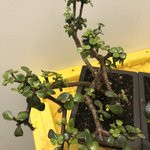Gravy Master
Seedling
Hello fellow small tree enthusiasts,
I have two indoor trees that I purchased a few months ago - one Chinese Elm and one Dwarf Jade. After getting them in August, I first did what I would consider an "official" repotting. Out of their plastic nursery pots and potting soil, roots trimmed, and into 6 inch plastic training pots with bonsai soil. Both trees are 7-8" in height.
I am now interested in getting them into larger training pots (9" pots) to try and thicken them up a bit. So my question is, can I simply move them into the larger pots with some more soil without causing any drastic shock or upset to them? I would do it without trimming the roots or being too rough with them. They are both extremely healthy right now and putting out lots of new buds and growth.
Or is repotting always repotting, and anytime you disrupt the tree from its environment regardless of how gentle you are, there is potential to harm the tree?
I have two indoor trees that I purchased a few months ago - one Chinese Elm and one Dwarf Jade. After getting them in August, I first did what I would consider an "official" repotting. Out of their plastic nursery pots and potting soil, roots trimmed, and into 6 inch plastic training pots with bonsai soil. Both trees are 7-8" in height.
I am now interested in getting them into larger training pots (9" pots) to try and thicken them up a bit. So my question is, can I simply move them into the larger pots with some more soil without causing any drastic shock or upset to them? I would do it without trimming the roots or being too rough with them. They are both extremely healthy right now and putting out lots of new buds and growth.
Or is repotting always repotting, and anytime you disrupt the tree from its environment regardless of how gentle you are, there is potential to harm the tree?


